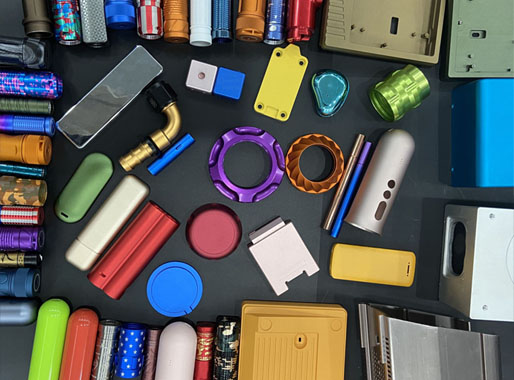15 years one-stop China custom CNC machining parts factory

Hey there I’m VMT Sam!
With 25 years of CNC machining experience we are committed to helping clients overcome 10000 complex part-processing challenges all to contribute to a better life through intelligent manufacturing. Contact us now
 276 |
Published by VMT at Feb 21 2024
276 |
Published by VMT at Feb 21 2024
Introduction:
In the field of CNC machined parts manufacturing, aluminum alloy is a common material extensively used in various products. However, during the CNC machining process, aluminum alloy parts are prone to fingerprints, adversely affecting both the aesthetic quality and performance of the product. Therefore, implementing surface treatment methods to prevent fingerprints on aluminum alloy CNC machined parts is crucial. This article provides a detailed overview of these methods to ensure an enhancement in product quality.

I. Causes of Fingerprints on the Surface of Aluminum Alloy CNC Machined Parts:
During the CNC machining process, the interaction between aluminum alloy material and cutting tools increases surface roughness, making it susceptible to fingerprint marks. The generation of these fingerprints is associated with the choice of cutting tools, the configuration of cutting parameters, and the characteristics of the material. Understanding these causes is essential for implementing effective measures to prevent fingerprints.

II. Methods for Preventing Fingerprints on the Surface of Aluminum Alloy CNC Machined Parts:
Selection of Appropriate Cutting Tools:
Choosing sharp cutting tools is crucial for aluminum alloy materials to minimize cutting forces, reduce surface roughness, and consequently decrease the likelihood of fingerprint formation.
Optimization of Cutting Parameters:
Cutting parameters such as cutting speed, feed rate, and cutting depth significantly impact the surface quality of aluminum alloy. Adjusting these parameters can lower cutting forces, diminish microscopic surface defects, and effectively prevent fingerprint formation.
Post-Machining Surface Treatment:
Conducting post-machining surface treatments, including polishing, sandblasting, and brushing, is essential to further smooth the surface and reduce the likelihood of fingerprint formation on CNC machined aluminum alloy parts.
Application of Anti-Fingerprint Coatings:
To more effectively prevent fingerprints, applying an anti-fingerprint coating on the surface of aluminum alloy parts is recommended. These coatings exhibit excellent resistance to fingerprints, abrasion, and weathering, maintaining the cleanliness and aesthetics of the parts over an extended period.
Control of Environmental Factors:
Maintaining a clean and dry machining environment is crucial to prevent fingerprint formation on the surface of aluminum alloy parts. Additionally, controlling temperature and humidity helps avoid material deformation and deterioration of surface quality due to environmental factors.
Regular Maintenance and Inspection:
To ensure the long-term effectiveness of fingerprint prevention measures, regular maintenance and inspection of CNC machining equipment are essential. This includes checking tool wear, adjusting cutting parameters, and cleaning dust and debris from the equipment's interior. Regular maintenance and inspection ensure that the equipment is in good working condition, enhancing the machining quality of aluminum alloy parts.
Employee Training and Management:
Strengthening employee training and management is vital to improving the level of fingerprint prevention on the surface of CNC machined aluminum alloy parts. Training employees on the importance of fingerprint prevention and proper operating procedures is crucial. Establishing strict management systems ensures that employees adhere to relevant regulations, reducing quality issues caused by human factors.
Quality Inspection and Feedback:
Establishing a comprehensive quality inspection system for strict quality checks on the surface of aluminum alloy CNC machined parts is essential. Through regular sampling and comprehensive inspections, potential fingerprint issues can be detected and addressed promptly. Encouraging employees to provide feedback facilitates continuous improvement and optimization of fingerprint prevention methods.
Conclusion:
To prevent fingerprints on the surface of aluminum alloy CNC machined parts, a comprehensive set of measures should be implemented. This includes selecting appropriate cutting tools, optimizing cutting parameters, conducting post-machining surface treatments, applying anti-fingerprint coatings, controlling environmental factors, regular maintenance and inspection of equipment, employee training and management, and establishing quality inspection and feedback mechanisms. Only through these combined efforts can the quality of CNC machined aluminum alloy parts be effectively improved, meeting customer expectations and requirements.
Ready To Start Your Next Project?
Get Instant Quote

Request a Free Quote
Send us a message if you have any questions or request a quote. We will get back to you ASAP!